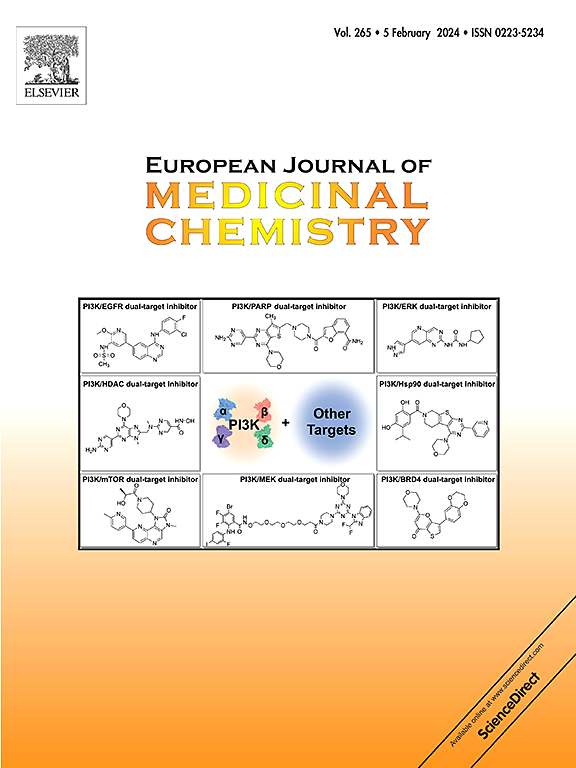Discovery and structure-activity relationship study of novel hydantoin-based inhibitors targeting mutant isocitrate dehydrogenase 1 (mIDH1)
IF 6
2区 医学
Q1 CHEMISTRY, MEDICINAL
引用次数: 0
Abstract
Mutations in isocitrate dehydrogenases (IDHs) are frequently observed in various malignancies. These mutations confer a neomorphic enzymatic activity, leading to the reduction of α-KG to the oncometabolite 2-HG. The aberrant accumulation of 2-HG inhibits α-KG-dependent histone and DNA demethylases, thus contributing to tumorigenesis. Consequently, considerable efforts have been directed toward the development of selective inhibitors targeting mutant IDHs. Herein, we report a high-throughput virtual screening campaign utilizing a chemical library of 1795658 compounds, which led to the identification of a promising IDH1 R132H inhibitor. Subsequent structure-based optimization yielded compounds 13e and 16a, which displayed potent inhibition of IDH1 R132H (IC50 = 0.26 and 0.22 μM) and IDH1 R132C (IC50 = 1.1 and 0.93 μM), while showing negligible activity against wt-IDH1 and wt-IDH2. Furthermore, both compounds effectively suppressed intracellular 2-HG production in U87-MG R132H cells (EC50 = 0.55 and 1.45 μM). Additionally, 13e and 16a exhibited moderate antiproliferative effects against U87-MG R132H and HT-1080 cells, while exhibiting low cytotoxicity toward normal human cells even at concentrations up to 40 μM.


靶向突变型异柠檬酸脱氢酶1 (mIDH1)抑制剂的发现及构效关系研究
异柠檬酸脱氢酶(IDHs)的突变在各种恶性肿瘤中经常观察到。这些突变赋予一种新形态的酶活性,导致α-KG减少为肿瘤代谢物2-HG。2-HG的异常积累抑制α- kg依赖性组蛋白和DNA去甲基化酶,从而促进肿瘤的发生。因此,针对突变IDHs的选择性抑制剂的开发已经付出了相当大的努力。在此,我们报告了利用1795658个化合物的化学文库进行高通量虚拟筛选活动,从而鉴定出一种有前途的IDH1 R132H抑制剂。化合物13e和16a对IDH1 R132H (IC50分别为0.26和0.22 μM)和IDH1 R132C (IC50分别为1.1和0.93 μM)具有较强的抑制作用,而对wt-IDH1和wt-IDH2的抑制作用可忽略。此外,这两种化合物都能有效抑制U87-MG R132H细胞内2-HG的产生(EC50分别为0.55和1.45 μM)。此外,13e和16a对U87-MG R132H和HT-1080细胞表现出中等的抗增殖作用,而对正常人细胞则表现出低的细胞毒性,即使浓度高达40 μM。
本文章由计算机程序翻译,如有差异,请以英文原文为准。
求助全文
约1分钟内获得全文
求助全文
来源期刊
CiteScore
11.70
自引率
9.00%
发文量
863
审稿时长
29 days
期刊介绍:
The European Journal of Medicinal Chemistry is a global journal that publishes studies on all aspects of medicinal chemistry. It provides a medium for publication of original papers and also welcomes critical review papers.
A typical paper would report on the organic synthesis, characterization and pharmacological evaluation of compounds. Other topics of interest are drug design, QSAR, molecular modeling, drug-receptor interactions, molecular aspects of drug metabolism, prodrug synthesis and drug targeting. The journal expects manuscripts to present the rational for a study, provide insight into the design of compounds or understanding of mechanism, or clarify the targets.

 求助内容:
求助内容: 应助结果提醒方式:
应助结果提醒方式:


